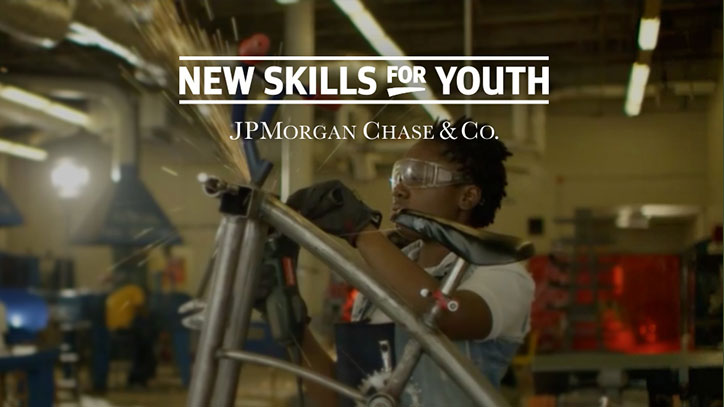The Shaping the Future Workforce series looks at innovative business solutions for developing skilled workers for 21st-century jobs.
JPMorgan Chase recognizes that the shape of work is changing around the world and believes businesses need to lead the way in building a workforce capable of changing along with it. The global financial giant believes the effort should start on the local level.
“Businesses should be coming together in sectors so that they can speak in one voice to the different education training providers in their communities,” says Chauncy Lennon. As Global Head of Workforce Initiatives, Lennon develops the strategy for how the JP Morgan Foundation invests its grant money. One of those initiatives is New Skills at Work, the company’s $250 million global effort to help close the skills gap.
The program targets specific communities, analyzing the skills that local employers are looking for, and the skills that area workers have. Once it identifies that gap in need and supply, it shares the information with local business leaders and education programs, and it invests in specific training programs aimed at filling those gaps.
The initiative has found that businesses are struggling to fill middle-skill jobs that require a high school diploma and some postsecondary training. In Chicago, they found high-demand for workers in healthcare and transportation. In Miami, the need was for IT and trade & logistics workers.
In Houston, New Skills at Work worked closely with the petrochemical sector, which is growing and in need of more trained workers. In addition to funding education programs to get locals skilled in the jobs needed, JPMorgan Chase also sponsors a website to help match workers with employers and encourage workers to go into the field.
RELATED STORY: JPMorgan Chase’s Fellowship Initiative expands its successful mentorship program
“There were a set of jobs that companies were having a hard time filling. This tool really gives people a lot of information about the jobs, like showing them how entry-level jobs, over time in combination with work experience and additional credentials and certification, ladder up into better pay, better quality jobs,” says Lennon.
JPMorgan Chase is also working to get more young people to consider middle-skill jobs at an earlier age. Lennon says that “failing to prepare young people with the right skills and education for these jobs is not just a missed opportunity for them, it’s a missed opportunity for businesses to hire the talent they need to grow and compete.”
New Skills for Youth is a competitive grant initiative designed to incentivize states to expand success education programs and create new ones aimed at getting more young people on the career pathway. “We’ve invested $75 million dollars in competitions among states which are committed to building better quality, greater rigor and more business-aligned career-focused education programs,” according to Lennon.
The Council of Chief State School Officers (CSSO), which is all the heads of the state education departments, and the National Association of State Directors of Career Technical Education Consortium (CTE) are partners in the initiative.
“We’re bringing together the two most important factors in education that are thinking about the questions about how we create opportunities for young people. Whether it’s healthcare, or in engineering, or in the trades, or in technology, we’re giving young people opportunities to prepare for both colleges and careers at the same time,” says Lennon.
The competition has awarded winning states three-year grants of up to $650,000 per year to implement the programs. “The effort is now in its second year. It’s been a very successful way to take a lot of the interests they have in strengthening their career-technical education programs and really adapt them for the demands of today’s economy,” Lennon tells me.
“Think of our dollars as the R-and-D, the research-and-development, dollars that need to be spent. What our dollars are doing is investing in things like innovation, re-engineering the business process, organizing programs of study in ways that allow more students to participate in them.”
The nation’s largest bank, JPMorgan Chase, finds itself in a competition of its own for highly-skilled workers. “It’s very competitive, especially for people coming out of four-year colleges or post-grad programs. We’re very deliberate about making the case to those young potential employees about the opportunities of working in the financial services sector,” according to Lennon
“A big financial services firm is, in many respects, a technology firm, right? Everything that we do has a technological dimension to it,” Lennon tells me. “These are folks that are going to be doing everything from programming to web design, to quality assurance, to cybersecurity. We need folks who come in with those skills that are then embedded into the kind of work that we do in the financial services sector.”
“When we’re talking about our hiring people who have a four-year B.A., many of those folks coming to JPMorgan Chase are going into what we call analysts programs. You start in one part of the bank and you’re intentionally moved around, so you’re exposed to different lines of business,” says Lennon.

The U.S. Department of Labor says there are as many as 500,000 tech jobs open right now. And fewer than 20 percent of the people studying computer science are women. That shrinks the talent pool for the 700 tech analysts JPMorgan Chase hires each year.
“If we’re just going to the 30 large, well-known colleges and universities that won’t really provide the full number of workers we need. So, we have a number of different efforts, which are thinking about how we reach out to different kinds of colleges and universities, how we create dedicated programs for candidates of color, female candidates, to make sure that the pipeline into our tech analyst program is diverse.”
One such program, Tech Connect, recruits college seniors from underrepresented backgrounds who have math and science skills but need more coding experience to join JPMorgan Chase’s programming group. The recruits are given Java training, sent to a multiweek boot camp, then they are put into a two-year Technology Analyst Program. JPMorgan Chase hired 60 analysts through the program last year.
JPMorgan Chase recognizes the importance of building a talented workforce with diverse experiences and mindsets. “It’s not just the question of race and ethnicity and gender. There’s lots of value to having people who have learned certain skills, but learned them in different contexts from a certain think tank at universities or colleges.”
In Houston, for example, the company has created a paid, entry-level apprenticeship for community college graduates with a degree in computer science. “People who do not have a four-year college degree, but are interested in roles within our tech and operations field, are able to come in and combine workplace experiences, work-based learning opportunities with a class of instruction. Over a course of two years, if successful, they graduate into a full-time position,” explains Lennon.
RELATED STORY: Shaping the Future Workforce – Jolen Anderson
JPMorgan Chase is committed to finding solutions to the skills gap, at a local level. “People often think that this is a just a problem of training. If we just train people, everything will be fine. But, really that training needs to be connected to demand,” says Lennon.
“We need to spend time making sure that businesses are well-positioned, and play an effective role, not just in signaling the kinds of skills they’re looking for, but also creating work-based learning opportunities. We keep on giving people opportunities to build their skills so that they can grow as our needs grow.”
Join the Conversation: Share your thoughts on the latest Shaping the Future Workforce article on our Facebook page.
Connect with Ramona via Twitter or her website. You can read her previous articles for WorkingNation at this link.












